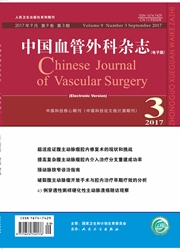

 中文摘要:
中文摘要:
目的探讨可回收腔静脉滤器置入联合患侧置管溶栓治疗下肢深静脉血栓形成(DVT)的早期和中期疗效。方法回顾性分析2009年2月~2012年10月期间我科收治的143例急性下肢DVT患者置管溶栓治疗的临床资料。通过静脉造影计算血栓溶解率来评价早期疗效;通过6个月和2年随访多普勒超声检查深静脉通畅率及Villalta评分测定深静脉血栓形成后综合征(PTS)发生率来评价中期疗效。结果 143例患者平均血栓溶解率为(84.3±26.1)%,成功溶解(血栓溶解率≥50%)129例(90.2%)。6个月和2年深静脉通畅率分别为76.3%和68.7%,2年后PTS发生率为16.5%。穿刺点血肿5例,无严重并发症发生。结论急性下肢DVT血管腔内置管溶栓疗效显著而且安全,并且可以提高深静脉通畅率和降低PTS发生的风险。
 英文摘要:
英文摘要:
Objective To explore the early and medium-term efficacy of catheter-directed thrombolysis(CDT) combined with retrievable vena cava filter for acute deep vein thrombosis(DVT) in the lower extremity. Methods The clinical data of 143 patients with acute DVT of lower extremities treated by CDT from February 2009 to October 2012 were analyzed retrospectively. Early efficacy was assessed with a thrombus score based on venography. Six months and 2 years follow-up included deep vein patency assessed with duplex ultrasound, and post- thrombotic syndrome (PTS ) assessed with the Villalta scale. Results The mean thrombolysis rate was (84.3±26.1)%, and successful thrombolysis (thrombolysis rate ≥ 50%)was obtained in 129 patients(90.2%). Deep vein patency after 6 months and 2 years were 76.3% and 68.7%, respectively. The incidence of PTS was 16.5%. Hematoma occurred in 5 cases at the puncture site, and no major complications happened. Conclusion CDT is safe and effective for acute DVT. It can increase lower extremity deep vein patency and reduce the risk of PTS.
 同期刊论文项目
同期刊论文项目
 同项目期刊论文
同项目期刊论文
 期刊信息
期刊信息
